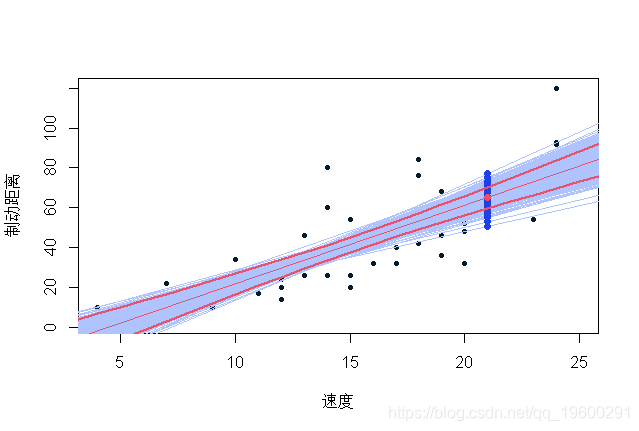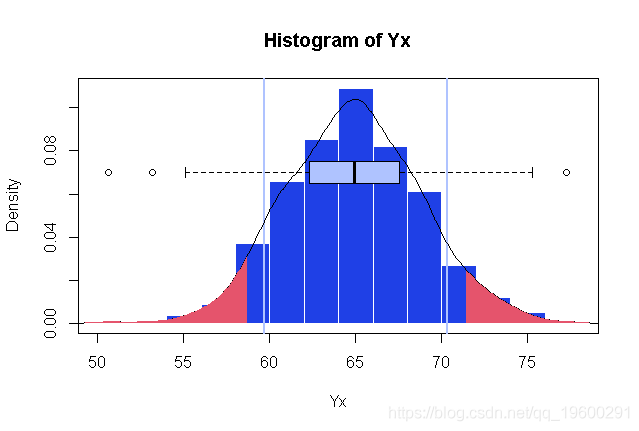reg|拓端tecdat|R语言基于Bootstrap的线性回归预测置信区间估计方法
原文链接:http://tecdat.cn/?p=21625
我们知道参数的置信区间的计算 , 这些都服从一定的分布(t分布、正态分布) , 因此在标准误前乘以相应的t分值或Z分值 。 但如果我们找不到合适的分布时 , 就无法计算置信区间了吗?幸运的是 , 有一种方法几乎可以用于计算各种参数的置信区间 , 这就是Bootstrap 法 。
本文使用BOOTSTRAP来获得预测的置信区间 。 我们将在线性回归基础上讨论 。
- > reg=lm(dist~speed,data=https://www.sohu.com/a/cars)
- > points(x,predict(reg,newdata= https://www.sohu.com/a/data.frame(speed=x)))

文章图片
这是一个单点预测 。 当我们想给预测一个置信区间时 , 预测的置信区间取决于参数估计误差 。
预测置信区间 让我们从预测的置信区间开始
- > for(s in 1:500){
- + indice=sample(1:n,size=n,
- + replace=TRUE)
- + points(x,predict(reg,newdata=https://www.sohu.com/a/data.frame(speed=x)),pch=19,col="blue")

文章图片
蓝色值是通过在我们的观测数据库中重新取样获得的可能预测值 。 值得注意的是 , 在残差正态性假设下(回归线的斜率和常数估计值) , 置信区间(90%)如下所示:
predict(reg,interval ="confidence",

文章图片
在这里 , 我们可以比较500个生成数据集上的值分布 , 并将经验分位数与正态假设下的分位数进行比较 ,
- > hist(Yx,proba=TRUE
- > boxplot(Yx,horizontal=TRUE
- > polygon(c( x ,rev(x I]))))

文章图片
可以看出 , 经验分位数与正态假设下的分位数是可以比较的 。
- > quantile(Yx,c(.05,.95))
- 5% 95%
- 58.63689 70.31281
- + level=.9,newdata=https://www.sohu.com/a/data.frame(speed=x))
- fit lwr upr
- 1 65.00149 59.65934 70.34364
- > for(s in 1:500){
- + indice=sample(1:n,size=n,
- + base=cars[indice,]
- + erreur=residuals(reg)
- + predict(reg,newdata=https://www.sohu.com/a/data.frame(speed=x))+E

文章图片
在这里 , 我们可以(首先以图形方式)比较通过重新取样获得的值和在正态假设下获得的值 ,
- > hist(Yx,proba=TRUE)
- > boxplot(Yx) abline(v=U[2:3)
- > polygon(c(D$x[I,rev(D$x[I])

文章图片
数值上给出了以下比较
- > quantile(Yx,c(.05,.95))
- 5% 95%
- 44.43468 96.01357
- U=predict(reg,interval ="prediction"
- fit lwr upr
- 1 67.63136 45.16967 90.09305
然后开始讨论在供应中使用回归模型 。 为了获得具有独立性 , 有人认为必须使用增量付款的数据 , 而不是累计付款 。
可以创建一个数据库 , 解释变量是行和列 。
- > base=data.frame(
- + y
- > head(base,12)
- y ai bj
- 1 3209 2000 0
- 2 3367 2001 0
- 3 3871 2002 0
- 4 4239 2003 0
- 5 4929 2004 0
- 6 5217 2005 0
- 7 1163 2000 1
- 8 1292 2001 1
- 9 1474 2002 1
- 10 1678 2003 1
- 11 1865 2004 1
- 12 NA 2005 1
- Coefficients:
- Estimate Std. Error t value Pr(>|t|)
- (Intercept) 7.9471 0.1101 72.188 6.35e-15 ***
- as.factor(ai)2001 0.1604 0.1109 1.447 0.17849
- as.factor(ai)2002 0.2718 0.1208 2.250 0.04819 *
- as.factor(ai)2003 0.5904 0.1342 4.399 0.00134 **
- as.factor(ai)2004 0.5535 0.1562 3.543 0.00533 **
- as.factor(ai)2005 0.6126 0.2070 2.959 0.01431 *
- as.factor(bj)1 -0.9674 0.1109 -8.726 5.46e-06 ***
- as.factor(bj)2 -4.2329 0.1208 -35.038 8.50e-12 ***
- as.factor(bj)3 -5.0571 0.1342 -37.684 4.13e-12 ***
- as.factor(bj)4 -5.9031 0.1562 -37.783 4.02e-12 ***
- as.factor(bj)5 -4.9026 0.2070 -23.685 4.08e-10 ***
- ---
- Signif. codes: 0 ‘***’ 0.001 ‘**’ 0.01 ‘*’ 0.05 ‘.’ 0.1 ‘ ’ 1
- Residual standard error: 0.1753 on 10 degrees of freedom
- (15 observations deleted due to missingness)
- Multiple R-squared: 0.9975, Adjusted R-squared: 0.9949
- F-statistic: 391.7 on 10 and 10 DF, p-value: 1.338e-11
- >
- exp(predict(reg1,
- + newdata=https://www.sohu.com/a/base)+summary(reg1)$sigma^2/2)
- [,1] [,2] [,3] [,4] [,5] [,6]
- [1,] 2871.2 1091.3 41.7 18.3 7.8 21.3
- [2,] 3370.8 1281.2 48.9 21.5 9.2 25.0
- [3,] 3768.0 1432.1 54.7 24.0 10.3 28.0
- [4,] 5181.5 1969.4 75.2 33.0 14.2 38.5
- [5,] 4994.1 1898.1 72.5 31.8 13.6 37.1
- [6,] 5297.8 2013.6 76.9 33.7 14.5 39.3
- > sum(py[is.na(y)])
- [1] 2481.857
- glm(y~
- + as.factor(ai)+
- + as.factor(bj),data=https://www.sohu.com/a/base,
- + family=poisson)
- Coefficients:
- Estimate Std. Error z value Pr(>|z|)
- (Intercept) 8.05697 0.01551 519.426 < 2e-16 ***
- as.factor(ai)2001 0.06440 0.02090 3.081 0.00206 **
- as.factor(ai)2002 0.20242 0.02025 9.995 < 2e-16 ***
- as.factor(ai)2003 0.31175 0.01980 15.744 < 2e-16 ***
- as.factor(ai)2004 0.44407 0.01933 22.971 < 2e-16 ***
- as.factor(ai)2005 0.50271 0.02079 24.179 < 2e-16 ***
- as.factor(bj)1 -0.96513 0.01359 -70.994 < 2e-16 ***
- as.factor(bj)2 -4.14853 0.06613 -62.729 < 2e-16 ***
- as.factor(bj)3 -5.10499 0.12632 -40.413 < 2e-16 ***
- as.factor(bj)4 -5.94962 0.24279 -24.505 < 2e-16 ***
- as.factor(bj)5 -5.01244 0.21877 -22.912 < 2e-16 ***
- ---
- Signif. codes: 0 ‘***’ 0.001 ‘**’ 0.01 ‘*’ 0.05 ‘.’ 0.1 ‘ ’ 1
- (Dispersion parameter for poisson family taken to be 1)
- Null deviance: 46695.269 on 20 degrees of freedom
- Residual deviance: 30.214 on 10 degrees of freedom
- (15 observations deleted due to missingness)
- AIC: 209.52
- Number of Fisher Scoring iterations: 4
- > predict(reg2,
- newdata=https://www.sohu.com/a/base,type="response")
- > sum(py2[is.na(y)])
- [1] 2426.985

文章图片
最受欢迎的见解
1.R语言多元Logistic逻辑回归 应用案例
2.面板平滑转移回归(PSTR)分析案例实现
3.matlab中的偏最小二乘回归(PLSR)和主成分回归(PCR)
4.R语言泊松Poisson回归模型分析案例
5.R语言回归中的Hosmer-Lemeshow拟合优度检验
6.r语言中对LASSO回归 , Ridge岭回归和Elastic Net模型实现
7.在R语言中实现Logistic逻辑回归
8.python用线性回归预测股票价格
9.R语言如何在生存分析与Cox回归中计算IDI , NRI指标
推荐阅读
- Linux|CentOS Kmods SIG正在研究exFAT和WireGuard的引入
- 广告|拓端tecdat|移动广告中基于点击率的数据策略
- XTrain|拓端tecdat|matlab使用长短期记忆(LSTM)神经网络对序列数据进行分类
- 分析|拓端tecdat|R语言文本挖掘NASA数据网络分析,tf-idf和主题建模
- 模型|拓端tecdat|R语言多元逐步回归模型分析房价和葡萄酒价格:选择最合适预测变量
- 偏差|拓端tecdat|在Python和R中使用交叉验证方法提高模型性能
- 网络|拓端tecdat|使用Python中Keras的LSTM递归神经网络进行时间序列预测
- 分析|拓端tecdat|stata马尔可夫Markov区制转移模型分析基金利率
- 期望值|拓端tecdat|R语言MCMC:Metropolis-Hastings采样用于回归的贝叶斯估计
- Copula|拓端tecdat|R语言Copula函数股市相关性建模:模拟Random Walk(随机游走)







